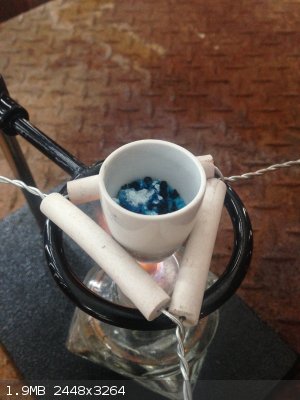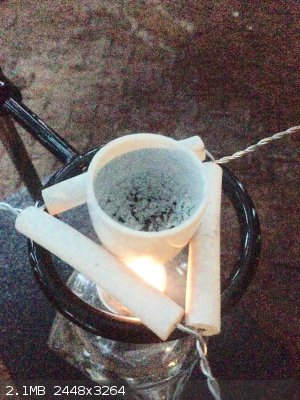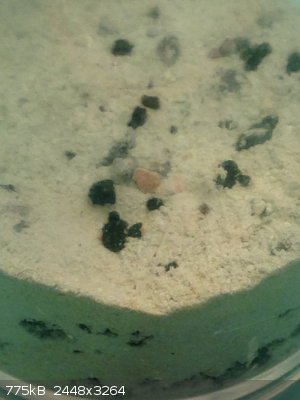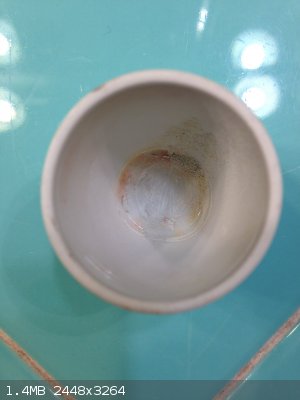A Halogenated Substance
Hazard to Self
 
Posts: 68
Registered: 7-2-2017
Location: United States
Member Is Offline
Mood: Oxidizing due to extended exposure to oxygen
|
|
Attempted to Reduce Copper Sulfate with Carbon - Ideas?
I decided I wanted to do a little bit of higher temperature chemistry and try to redox metal salts with activated charcoal.
To start off, I added 5.0 grams (0.02 mol) of copper(II) sulfate pentahydrate and 0.90 grams (0.08 mol) of activated charcoal to a crucible (I used a
large excess to push the reaction forward for a noticeable formation in copper; this wasn't for the purpose of collecting the copper product as it was
for attempting the reaction).
Now as for a heat source... an alcohol burner.
Expected reaction(s):
CuSO4*H2O -heat-> CuSO4 + H2O
CuSO4 + C -heat-> Cu + SO2 + CO2
I let the vessel heat for several minutes and occasionally stirred the mixture with a glass stir rod to allow for better heating. Eventually, the
hydrated copper(II) sulfate turned white.
 
30 minutes later... I placed on a lid to the crucible to try to keep in heat. Stirred occasionally.
And nothing.  
"Oh well... better keep the reaction mixture and clean up."
After letting the vessel cool and pouring the mixture into a small plastic container for storage, I noticed some tiny brownish areas...
 
I was hoping that this indicated that I managed to redox at least tiny amount of the copper(II) sulfate to copper.
So obviously the reaction didn't go so well but I'm planning on doing some things to try to improve it...
-powderize the reaction mixture better in a mortar and pestle
-get a better heat source
*I could try to heat the crucible directly in a steel firepit with a wood fire.
*I could use a propane burner (I don't have a Bunsen burner)
-I could just straight up wait longer with my alcohol burner if all else...
Anyone have better or alternative ideas on how to improve this?
Thank you for any feedback!
|
|
|
DraconicAcid
International Hazard
    
Posts: 4334
Registered: 1-2-2013
Location: The tiniest college campus ever....
Member Is Offline
Mood: Semi-victorious.
|
|
If the sulphate didn't even decompose to the oxide (and turn black), you really weren't heating it enough.
Please remember: "Filtrate" is not a verb.
Write up your lab reports the way your instructor wants them, not the way your ex-instructor wants them.
|
|
|
A Halogenated Substance
Hazard to Self
 
Posts: 68
Registered: 7-2-2017
Location: United States
Member Is Offline
Mood: Oxidizing due to extended exposure to oxygen
|
|
https://pubchem.ncbi.nlm.nih.gov/compound/Copper_sulfate#sec...
The decomposition point is about 500-600 degrees celsius?
And it doesn't displace as copper until after decomposition?
Alright, maybe no alcohol burner.
I assume a propane gas burner would be able to reach this point however?
|
|
|
MrHomeScientist
International Hazard
    
Posts: 1806
Registered: 24-10-2010
Location: Flerovium
Member Is Offline
Mood: No Mood
|
|
When I tried this reaction, I used (basic) copper carbonate made from copper sulfate and baking soda. When heated, first the carbonate decomposes:
CuCO<sub>3</sub> --> CuO + CO<sub>2</sub> *
Then the copper oxide reacts with carbon to produce Cu metal:
2CuO + C --> 2Cu + CO<sub>2</sub>
The key on the second reaction is that there is a CO intermediate product that actually does the reducing, so the reaction must be covered to prevent
its escape for best results. I produced Cu nuggets from crushed malachite this way; very satisfying experiment!
*This is a simplification, of course, since actual copper carbonate is CuCO<sub>3</sub>.Cu(OH)<sub>2</sub>.
|
|
|